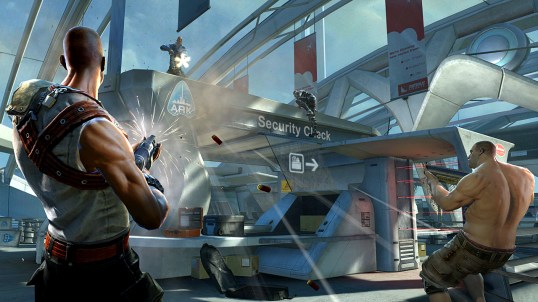What happens to society when you run out of resources? That’s the question lurking in the background of new post-apocalyptic first-person shooter Brink. On a massive floating city known as the Ark, two extremes of troubling human behavior come to the fore in view of the game’s theme: perpetual conflict. The Security faction wants to lock down a draconian order to prolong survival while the Resistance tries to cause enough chaos to snatch the tools to escape and see if things might be better elsewhere. You can play as each and the choice of faction at the beginning of the single-player game feels charged, like the fate of civilization is at stake.
The decay of the once-glistening Ark after an unnamed eco-disaster left it adrift and cutoff from the outside world gives rise to wonderfully detailed environmental art. The Founders–Brink‘s “haves”–and their Security live in upscale apartments filled with gleaming, curved surfaces while the impoverished, euphemistically named Guests hole up in the scrap-metal patchwork shelters of Container City. The jarring switch between art styles drives home what’s at stake in each skirmish. The narrative design of Brink means you don’t have to play it in order, emphasizing the play experience. There is a story, of course, one composed of tense moments over an eight-day conflict as the Resistance tries to escape and the Security attempts to quell the rebellion.
[vodpod id=Video.8357492&w=425&h=350&fv=%26rel%3D0%26border%3D0%26]
That said, Brink‘s still very much an FPS about drilling holes in opponents and it presents some elegant ideas that feel fresh amongst the familiar run-and-gun tropes. Its biggest triumph emerges in its molding of the online experience. How big a triumph? I did something I never do with online games: I played with strangers. Even with the voice chat off, we could continue to work towards a common goal and help each other along the way. Valve’s Left4Dead broke new ground by symbiotically linking resources among the survivors of that series’ zombie apocalypses, but the reward there was more emotional. It’s a bit more ephemeral to have “Yay, we all made it out!” as a reward. Brink ponies up cold hard experience points (XP) and that makes the experience incredibly sticky. You want to keep hammering at missions multiple times in multiple roles to increase your Soldier, Medic, Engineer or Operative skills.
Everything you do earns XP, even if you’re unsuccessful in a particular mission–you’re still getting points that will unlock new gear weapons and abilities. One of Brink‘s wrinkles is that you get more XP for good teamplay, like giving teammates health, ammo or better weapon performance. Mind you, the screen in Brink gets very busy and your brain will have to learn how to parse all the data that’s being thrown at you. At any given moment, a superior’s yelling at you about a command post, you’re being prompted to heal, supply or buff teammates. Once you get the hang of it, you can contribute to each firefight in specific ways that changes often.
There’s a mix-n-match, polyglot sensibility underlying most of Brink. You can make a character look singularly unique, switch your combat role during a mission at almost anytime, and even in death, decide to hold position and wait for a revive or respawn as part of another wave. The customization potential is exponentially huge, even if you go for the paramilitary look of Security or ragamuffin Resistance threads.
Brink‘s primarily designed as a multiplayer experience, to the point where even if you’re playing solo it feeds back into the stats, gear and abilities you’ll be using online. And players can jump into open public games, but that clever orientation exposes Brink’s biggest flaw.
The network portion of Brink is badly broken right now. Over the last few days, I’ve experienced lots of lag while playing. There’s been terrible hitching and stuttering, to the point where lip syncing in cutscenes is off. The latency renders the game unplayable at times, with basic actions like aiming or moving around impossible to execute. I’ve even gone back to check if the day-one patch offered at launch would help things, but I’m not seeing much improvement. You’re going to need a lot of patience if you want to see what Splash Damage has to offer.
Still, there’s something pulpy about Brink. The modular story design feels a bit like Saturday morning serials and the rough, beat-up aesthetic of the world gives a decidedly bare-knuckle feel to the proceedings. Another thing I love about Brink is how you can choose your character’s voice from the distinct dialect of the Chinese, West African, Irish or Caribbean voice actors. So, yes: It looks good, it sounds good and, when it works, it plays well. Alas, the unreliability of multiplayer dilutes nearly everything that’s great about the game. The solo campaign works on the same principles but the AI comrades you’re given don’t partner as well as real humans.
There’s hope for Brink however: netcode and online stability are things that can be improved and probably will soon. I’m going to recommend Brink, though with strong caveats about the online issues. It’s still a really forward-looking shooter with a nearly improvisatory energy that creates dynamic roleplay centered on positive social engineering. For a game built on maneuvering around obstacles in evolutionary fashion, consider it an investment in an intriguing future.
Techland Score: 8.1 out of 10


